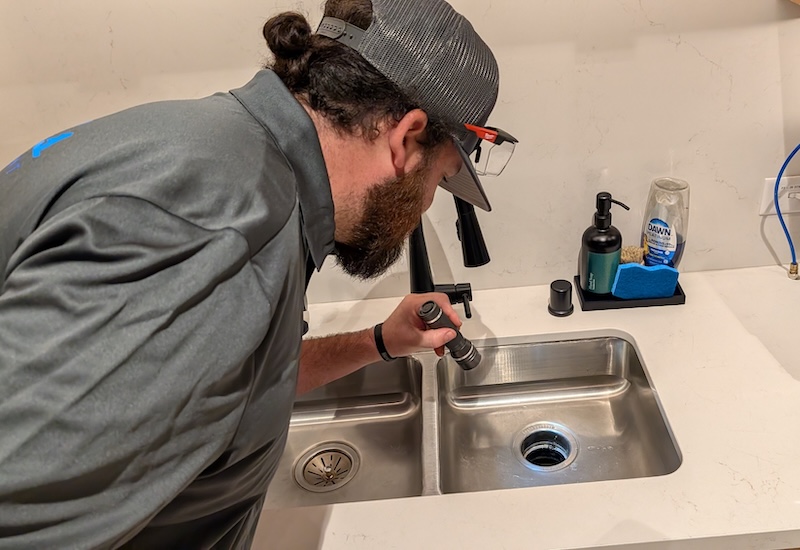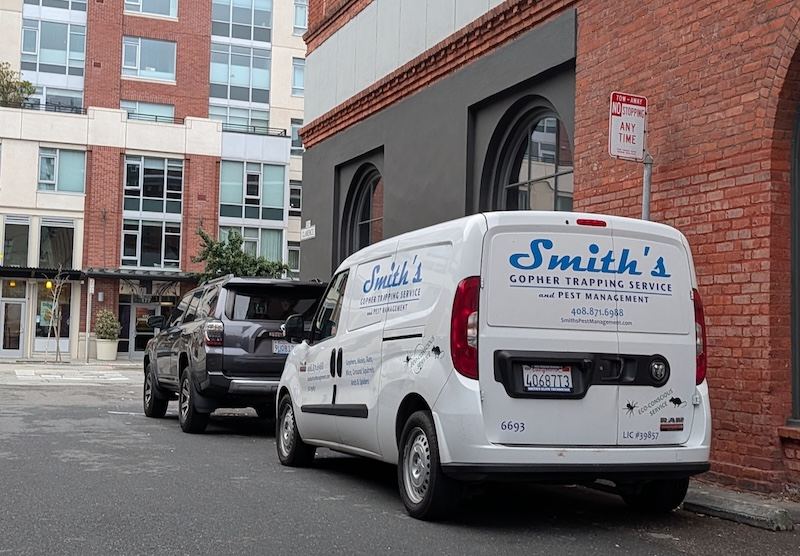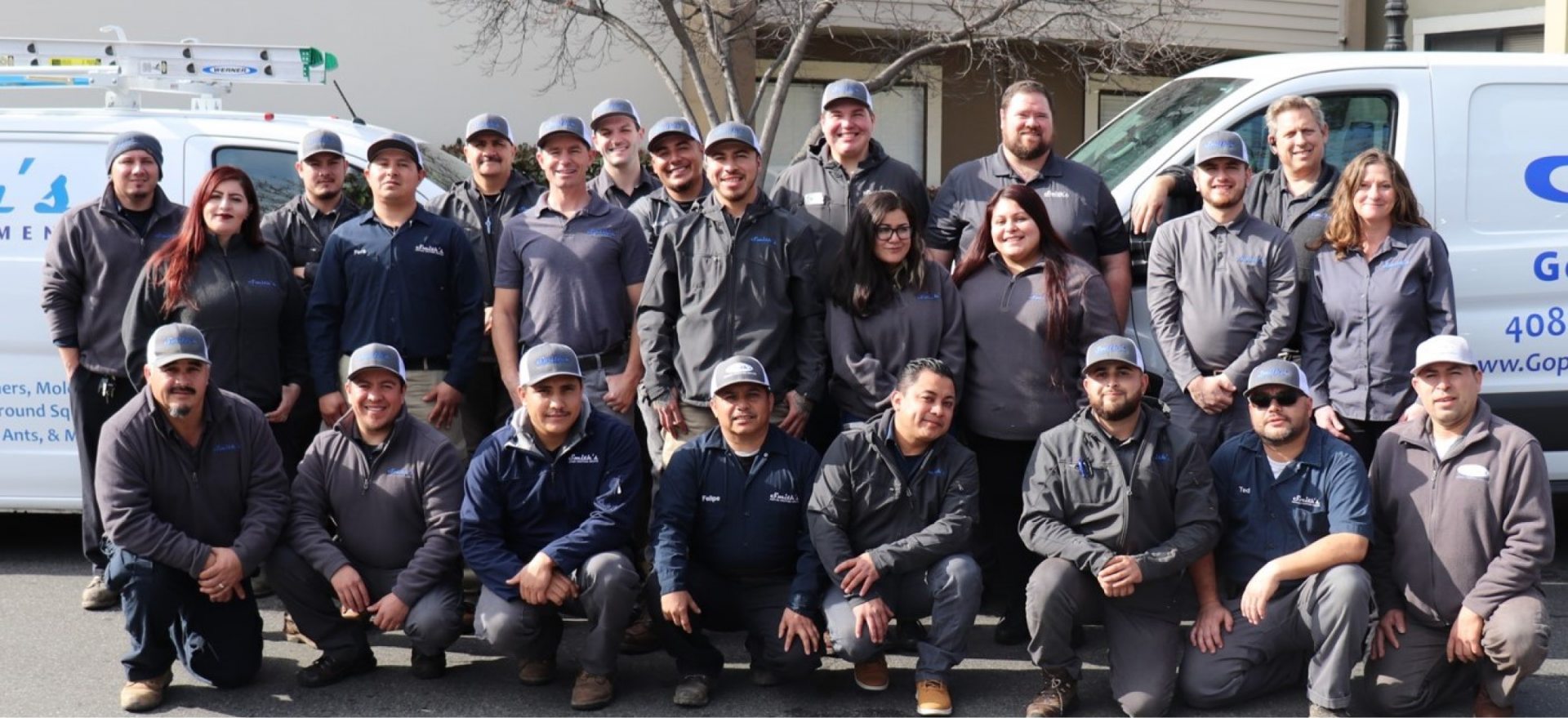At Smith’s Pest Management, we’ve worked with hundreds of San Francisco Bay Area office properties, and we often hear the same concern: “We’re paying for pest control, but the problem isn’t going away.”
After years of solving pesky rodent, ant, and cockroach issues in large buildings, we’ve seen exactly why standard pest control fails and how to fix it.
Why Pest Control Fails in Office Buildings

1. Not Enough Traps or Bait
In large buildings, a few traps or small bait stations aren’t enough.
A mouse, ant, or roach infestation escalates quickly, so underestimating the scale of the population means you’re always playing catch-up.
Pro Tip: Make sure traps and bait stations cover every active area. In large offices, place rodent traps every 10–20 feet along walls, set ant bait stations in known or suspected activity zones, like near cabinets or equipment, and for cockroaches, use 12–15 bait stations in kitchens and apply small dabs of bait in cracks, crevices, and other hiding spots.
2. Overlooking the Exterior and Entry Points
Most infestations don’t start inside – they begin outdoors.
Landscaping, dumpsters, irrigation leaks, and nearby structures can all attract pests that eventually move into the building.
Once they’re close, even the smallest opening becomes an easy way in.
Rodents can fit through a gap the size of a dime, and insects need even less space.
Pro Tip: Trim vegetation touching walls, repair irrigation leaks, and keep trash areas clean and sealed. Check for cracks, open vents, and gaps around pipes or door sweeps. Seal every possible opening and place outdoor traps or bait stations near dumpsters and utility lines to intercept pests before they enter.
3. Overlooking the Attractants
Pests enter for food, water, or shelter. Office kitchens, break rooms, and storage areas often provide all three.
Without removing what’s attracting pests, treatments will only be temporary.
Pest Pro Tip: Keep all food in sealed containers and fix leaks quickly. Even a small water source, like a dripping pipe, can sustain pests such as cockroaches, ants, and rodents.
4. Poor Team Communication
Effective pest control takes coordination between everyone who manages the property.
Janitorial crews, landscapers, property engineers, and pest control technicians should share updates on sanitation issues, leaks, trash handling, and recent pest sightings.
When teams don’t communicate, minor issues such as leaks, trash buildup, or overgrown landscaping can quickly lead to new infestations.
Pro Tip: Hold a quarterly meeting with all service providers to review pest activity, sanitation practices, and maintenance needs. Use a shared pest log or inspection checklist to keep everyone on the same page year-round.
6. Inexperienced Pest Control Technicians
Not every pest technician is trained to solve complex infestations.
If they’re just spraying baseboards, they’re not addressing root causes.
Pro Tip: Choose a local commercial pest control partner with seasoned technicians who know how to investigate complex infestations. At Smith’s, our Bay Area team specializes in solving the tough “mystery cases” that less experienced providers often miss.
7. Property Managers Lacking Clear Guidance
You can’t be a pest expert on top of everything else. But without clear guidance and the right questions to ask, it’s easy to miss when a pest control plan isn’t working.
The solution is to work with a provider who explains their findings, shares a clear action plan, and keeps you informed every step of the way.
Pro Tip: Ask your pest control technician: Where are pests nesting? How are they getting in? What changes are needed in cleaning, landscaping, or building maintenance?
How Smith’s Keeps Bay Area Offices Pest-Free

At Smith’s Pest Management, we know office buildings require more than routine spraying or trap placement.
Our approach is different:
Intelligent Pest Management
We take a science-based, eco-friendly approach that looks at the entire property, from landscaping and irrigation to trash handling and building systems, to identify and eliminate the root causes of infestations.
Pest Consulting & Training
We go beyond standard pest control by offering peer-reviewed pest consulting services designed for property managers who need solutions when other plans fall short.
As part of this, we provide on-site training and support for janitorial, engineering, and landscaping teams, equipping them to spot early signs of pest activity and take action before problems grow.
Local Expertise
Based in the Bay Area, our team specializes in solving the toughest commercial pest problems with strategies that are effective, sustainable, and compliant with local regulations.
With nearly 20 years of experience, Smith’s is the partner property managers trust to protect their buildings and keep tenants happy.
Take Control of Office Pest Problems Today
Pest problems in office buildings get worse if left unchecked.
Smith’s Pest Management brings local expertise and a fresh perspective to eliminate infestations and keep them from coming back.
We proudly serve businesses south of the San Mateo Bridge, including North San Jose, South Fremont (Tesla area), Milpitas, Sunnyvale, Santa Clara, and nearby districts.
Call (408) 871-6988 today to schedule a consultation and protect your building from future pest issues.
FAQs
How often should office buildings be inspected for pests?
Most offices benefit from monthly inspections, but high-traffic or food-heavy buildings may require more frequent checks.
Regular inspections help catch small issues, like early rodent activity or cockroach traces, before they become infestations.
Are eco-friendly pest control methods effective in commercial buildings?
Yes. Modern Integrated Pest Management (IPM) strategies use targeted treatments, exclusion, and sanitation improvements to control pests effectively without heavy reliance on chemicals.
At Smith’s, we prioritize eco-friendly methods that are safe for employees, tenants, and the environment.
What pests are most common in office buildings?
Rodents, ants, and cockroaches are the most frequent problems, but office buildings can also attract flies, silverfish, and spiders, depending on the season and building conditions.
Regular monitoring helps identify and manage these pests before they spread.


